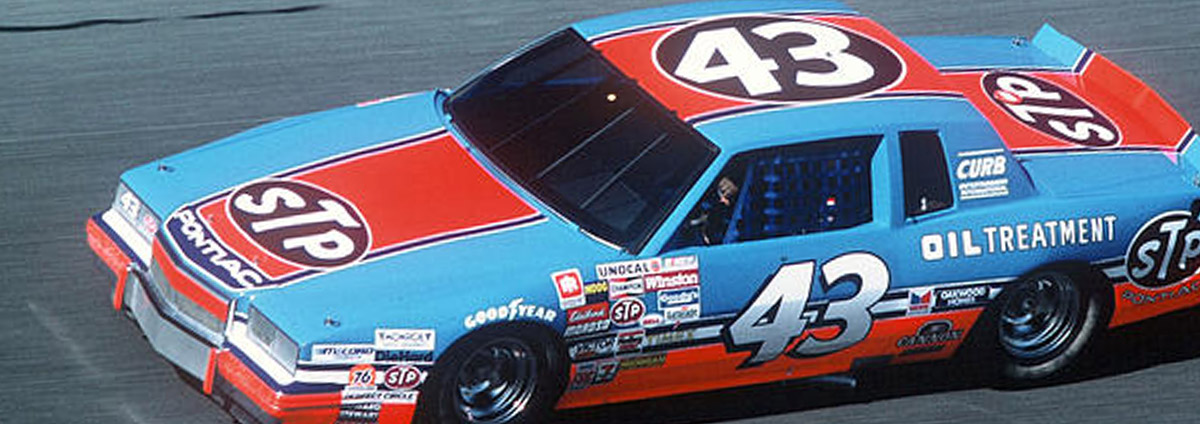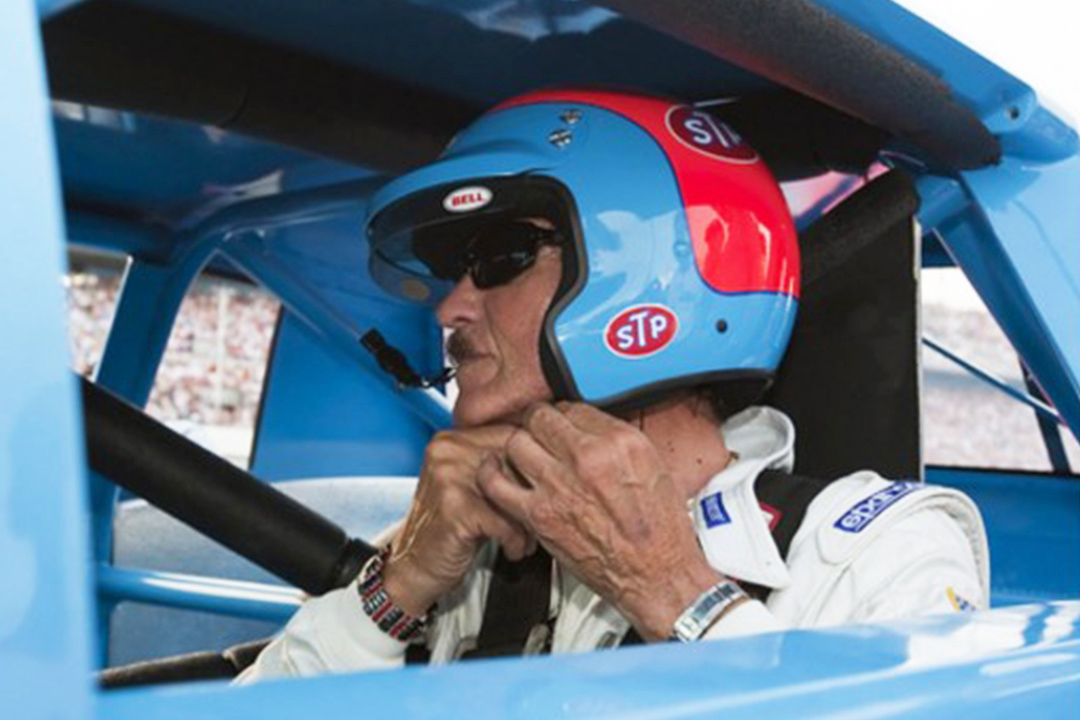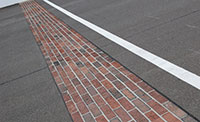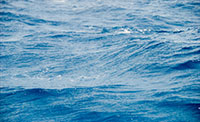

Richard Petty
Richard Lee Petty (born July 2, 1937), nicknamed The King, is a former NASCAR driver who raced in the Strictly Stock/Grand National Era and the NASCAR Winston Cup Series. He is best known for winning the NASCAR Championship seven times (Dale Earnhardt is the only other driver to accomplish this feat), winning a record 200 races during his career, winning the Daytona 500 a record seven times, and winning a record 27 races (10 of them consecutively) in the 1967 season alone (a 1972 rule change eliminated races under 250 miles (400 km) in length, reducing the schedule to 30 races). Statistically, he is the most accomplished driver in the history of the sport and is one of the most respected figures in motorsports as a whole. He also collected a record number of poles (127) and over 700 Top 10 finishes in his 1,184 starts, including 513 consecutive starts from 1971—1989. Petty was the only driver to ever win in his 500th race start, until Matt Kenseth joined him in 2013. He was inducted into the inaugural class of the NASCAR Hall of Fame in 2010.
Petty is a second generation driver. His father, Lee Petty, won the first Daytona 500 in 1959 and was also a three-time NASCAR champion. His son Kyle is also a well-known NASCAR driver. His grandson, Adam, was killed in a practice crash at New Hampshire International Speedway on May 12, 2000, five weeks after Lee's death. Adam's brother Austin works on day-to-day operations of the Victory Junction Gang Camp, a Hole in the Wall Gang Camp established by the Pettys after Adam's death. Petty married Lynda Owens in 1958. She died on March 25, 2014 at her home in Level Cross, North Carolina at age 72, after a long battle with cancer. They had four children—Kyle Petty, Sharon Petty-Farlow, Lisa Petty-Luck, and Rebecca Petty-Moffit. The family resides in Petty's home town of Level Cross, North Carolina and operates Richard Petty Motorsports. The Richard Petty Museum was formerly in nearby Randleman, North Carolina but moved back to its original location in March 2014.
Petty was born in Level Cross, North Carolina to Elizabeth (née Toomes) and Lee Arnold Petty, also a NASCAR driver, and the older brother of Maurice Petty. He began his NASCAR career on July 18, 1958, 16 days after his 21st birthday. His first race was held at CNE Stadium in Toronto, Canada. In 1959, he was named NASCAR Rookie of the Year, after he produced 9 top 10 finishes, including six Top 5 finishes.(21) In Lakewood Georgia in 1959, Petty won his first race, but his father Lee protested, complaining of a scoring error on the officials' part. Hours later, Lee was awarded the win.(20)
The 1960s
In 1960, he finished 2nd in the NASCAR Grand National Points Race. 1963 was his breakout year, winning at tracks like Martinsville and Bridgehampton. In 1964, driving a potent Plymouth with a new Hemi engine, Petty led 184 of the 200 laps to capture his first Daytona 500, en route to 9 victories, earning over $114,000 and his first Grand National championship.
Joining in the Chrysler boycott of NASCAR due to the organizing body's ban of the Hemi engine, Petty spent much of 1965 competing as a drag racer. Petty Enterprises installed the Hemi in the new compact Barracuda and lettered "OUTLAWED" on the door. He crashed this car at Southeastern Dragway, in Dallas, Georgia, on February 28, 1965, killing a six-year-old boy and injuring seven others. Petty, his father Lee, and Chrysler Corporation faced lawsuits totaling more than $1 million, though Petty and his team came to settlements with the lawsuits within 1 month of the suits being filed. Afterwards, a second Hemi Barracuda was built, this time with an altered wheelbase and eventually with Hilborn fuel injection. This car was lettered with a large "43 JR" on the door. The car was very successful, winning its class at the Bristol Spring Nationals and competing in many match races against well known racers such as Ronnie Sox, Don Nicholson, Phil Bonner, Huston Platt, Hubert Platt and Dave Strickler. Even after returning to NASCAR once the Hemi was reinstated, Richard continued drag racing the 43 JR until early 1966.
On February 27, 1966, Richard Petty overcame a 2-lap deficit to win his second Daytona 500 when the race was stopped on lap 198 of 200 because of a thunderstorm. This made him the first driver to win the event twice. 1967 was a milestone year. In that year, Petty won 27 of the 48 races he entered, including a record 10 wins in a row (between August 12 and October 1, 1967). He won his second Grand National Championship. One of the 27 victories was the Southern 500 at Darlington, which would be his only Southern 500 victory. His dominance in this season earned him the nickname "King Richard". He had previously been known as "the Randleman Rocket".
In 1969, Petty switched brands to Ford, due to his belief the Plymouth was not competitive on super-speedways; he wanted a slippery Dodge Daytona but Chrysler executives insisted he stay with Plymouth. He would win 10 races and finish second in points. Won back in 1970 by the sleek new Plymouth Superbird with shark nose and towel rack wing, Petty returned to Plymouth for the 1970 season. This is the car in which Petty is cast in the Pixar film Cars (2006), in which Richard and Lynda Petty had voice roles.
The 1970s
On February 14, 1971, Petty won his third Daytona 500, driving a brand-new (for 1971) Plymouth Road Runner and beating Buddy Baker, by little more than a car length en route to another historic year, making him the first driver to win the race 3 times. He won 20 more races (which would make him become the first driver to earn more than $1 million in career earnings) and claimed his 3rd Grand National Championship. At the end of the 1971 season, Chrysler told the Pettys they no longer would receive direct factory funding support; this gave the Petty team great concern. In 1972, STP began what would turn into a successful 28-year sponsorship arrangement with Petty, however it marked the end of his famous all "Petty Blue" paint job. STP previously insisted on an all STP orangish-red color for the cars, but Petty balked and after an all-night negotiation session, the familiar STP orange/"Petty blue" paint scheme was agreed to as a compromise that would find its way to all STP racing operations, most notably Gordon Johncock's win in the 1982 Indianapolis 500. Thanks to his 28 Top 10 finishes (25 Top 5 finishes and 8 victories), Petty went on to win his 4th Winston Cup Championship. 1972 was a year of change in other ways, as it was the last year where Petty would campaign a Plymouth-based race car; as in the middle of the year, he debuted to drive a newly built 1972 Dodge Charger in a few races (winning one of them), as he believed that the car would have a slight aero advantage over the Plymouth body style. In a driver's duel on February 18, 1973, Petty, in a newly built 1973 Dodge Charger (a body style he would use exclusively until the end of 1977), outlasted Baker (now with the K&K Insurance Dodge race team) to win his 4th Daytona 500 after Baker's engine gave out with 6 laps to go. A year later, Petty won the Daytona "450" (shortened 20 laps {50 mi/80 km} due to the energy crisis) for the fifth time en route to his 5th Winston Cup Championship.
1975 was another historic year for Petty, as he won the World 600 for the first time in his career, one of 13 victories en route to his 6th Winston Cup. The 13 victories is a modern (1972–present) NASCAR record for victories in a season, and was tied in 1998 by Jeff Gordon, although Gordon won 13 out of 33 races, compared to Petty's 13 out of 30 races. In 1976, Petty was involved in one of the most famous finishes in NASCAR history. Petty and David Pearson were racing on the last lap out of turn 4 in the Daytona 500. As Petty tried to pass Pearson, at the exit of turn 4, Petty's right rear bumper hit Pearson's left front bumper. Pearson and Petty both spun and hit the front stretch wall. Petty's car came to rest just yards from the finish line, but his engine stalled. Pearson's car had hit the front stretch wall and clipped another car, but his engine was running. Pearson was able to drive his car toward the finish line, while Petty's car would not restart. Pearson passed Petty on the infield grass and won the Daytona 500. Petty was given credit for second place.
Oddly 1978 will stand out as the one year during his prime that Petty did not visit the winners circle. The Petty Enterprises Team could not get the new 1978 Dodge Magnum to handle properly, even though much time, effort, and faith were spent massaging the cars. Unhappy with the seven top-five and eleven top ten finishes (including two-second places), Petty decided that his longtime relationship with Chrysler could not continue and he instead began racing a secondhand 1974 Chevrolet Monte Carlo at the fall race at Michigan. Returning to the General Motors fold proved successful as Petty recorded six top ten finishes in the final ten races of the 1978 season and finished sixth in the final standings. He would go on to even better results in 1979. Petty won the Daytona 500 in an Oldsmobile Cutlass Supreme and ran most of the remaining races in a Chevrolet, winning four additional races and taking the NASCAR championship for the seventh, and last, time by 11 points which was the closest points margin in NASCAR history until 1992.
The Twilight years
Petty won two more Daytona 500s in 1979 and 1981. In 1979, he snapped a 45-race drought, winning his sixth Daytona 500, the first to be televised live flag-to-flag; it would become notorious for a fist fight between competitors following the controversial finish. Petty won the race as the first and second place cars of Donnie Allison and Cale Yarborough crashed on the last lap. Petty held off Darrell Waltrip and A. J. Foyt. The race is also regarded as being the genesis of the current surge in NASCAR's popularity. The East Coast was snowed in by a blizzard, giving CBS a captive audience. The win was part of Petty's seventh and last NASCAR Winston Cup Championship. He was able to hold off Waltrip to win the title in 1979.
For 1981, NASCAR dictated that all teams had to show up with the new downsized cars of 110" wheel-base, that Detroit had been building since 1979. Though Petty had been successful with the Chevrolet and Oldsmobile cars he had been running, he wanted to get back to his Mopar roots. After taking a phone call from Lee Iacocca (who personally asked Petty to campaign a Dodge for 1981), the Petty team built a stunning 1981 Dodge Mirada and took it to Daytona in January 1981 for high speed tests. Petty's fans were also in a large part fans of his Dodges, so when word got out about the Mirada testing, 15,000 or so showed up on January 17, 1981 at Daytona Speedway to watch Petty put the Dodge through its paces. Sadly for the fans, the car could do no better than 186 miles per hour, about eight miles per hour slower than the GM and Ford cars. Petty gave up on returning to Dodge knowing that for the superspeedways the Mirada would not be competitive, and bought a Buick Regal for the Daytona race. In the 1981 Daytona 500, Petty used a "fuel only" for his last pit stop, with 25 laps to go, to outfox Bobby Allison and grab his seventh and final Daytona 500 win. This win marked a large change in Petty's racing team. Dale Inman, Petty's longtime crew chief, left the team after the Daytona victory (Inman would win an eighth championship as crew chief in 1984 with Terry Labonte).
While the 1981 season gave Petty 3 wins, he felt the season was a failure, and the Regals being ill-handling and poor in reliability. For 1982, he made the move to the Pontiac Grand Prix, with the promise of substantial factory support from Pontiac. 1982 was a repeat of 1978, and no victories were to be had. At first, the Grand Prix behaved much like the Dodge Magnum of 1978, with handling and speed problems. Toward the end of 1982 things improved with several top-10 finishes, which opened the door to a successful 1983 season with three victories, and several top-5 and top-10 finishes. In 1983, he broke his 43-race winless streak from 1982 with a win in the 1983 Carolina 500, barely edging out a young Bill Elliott. After a controversial win at Charlotte in October 1983 (win No. 198), Petty left the race team his father founded for the 1984 season. He spent '84 and '85 driving for Mike Curb before returning to Petty Enterprises in 1986.
On July 4, 1984, Petty won his 200th (and what would turn to be his final victory) race at the Firecracker 400 at Daytona International Speedway. The race was memorable: On lap 158, Doug Heveron crashed, bringing out the yellow caution flag, essentially turning lap 158 into the last lap as the two drivers battled back to the start-finish line. Petty and Cale Yarborough diced it out on that lap, with Yarborough drafting and taking an early lead before Petty managed to cross the start/finish line only a fender-length ahead. (This is no longer possible because of the 2003 rule change freezing the field immediately upon caution. Furthermore, the green-white-checkered rule was created for if the yellow flag waves with two laps remaining, but not with one lap remaining.) President Ronald Reagan was in attendance, the first sitting president to attend a NASCAR race. Reagan celebrated the milestone with Petty and his family in victory lane.
In early 1988, Petty travelled to Australia to help promote a NASCAR exhibition race at the then new Calder Park Thunderdome, the first NASCAR race outside of North America. While he did not compete in the tracks inaugural race, the Goodyear NASCAR 500 (though his son Kyle did), in testing at the 1.119 mi (1.801 km) track which owner Bob Jane had modelled on the Charlotte Motor Speedway, Richard Petty set an unofficial lap record of 28.2 seconds (142.85 mp/h). This would have in fact landed him on pole position for the race as the fastest time in official qualifying was by Alabama Gang member Neil Bonnett who recorded a 28.829-second lap (139.734 mp/h) in his Pontiac Grand Prix.
Petty's Last Ride
On October 1, 1991, Petty announced he would retire after the 1992 season. Petty's final top ten finish came at the 1991 Budweiser at the Glen which was the same race J. D. McDuffie was killed in a fifth lap accident. Petty chose to run the entire 1992 season, not just selected events as other drivers have done before retirement. His year-long Fan Appreciation Tour took him around the country, participating in special events, awards ceremonies, and fan-related meetings. Racing Champions ran a promotional line of diecast cars for every race in Petty's Farewell Tour. In his final year behind the wheel, he had two notable races.
At the 1992 Pepsi 400 on July 4, Petty qualified second. Before the start of the race, he was honored with a gift ceremony which included a visit from President George H. W. Bush. At the start, Petty led the first five laps, but dropped out on lap 84 due to fatigue.
Despite the tremendously busy appearance schedule, and mediocre race results, Petty managed to qualify for all 29 races in 1992. On his final visit to each track, Petty would lead the field on the pace lap to salute the fans. Petty's final race was the season-ending Hooters 500 at Atlanta Motor Speedway. The race was notable in that it was the first career start for Jeff Gordon, and it was the 2nd closest points championship in NASCAR history, with six drivers mathematically eligible to win the championship. A record 160,000 spectators attended the race, which went down to the final lap with Bill Elliott winning the race, and Alan Kulwicki winning the championship by 10 points over Elliott after Davey Allison dropped out early after a crash.
Facing the intense pressure, Petty barely managed to qualify at Atlanta, posting the 39th fastest speed out of 41 cars. He would not have been eligible for the provisional starting position, and had to qualify on speed. On the 94th lap, Petty became tangled up in an accident, and his car caught fire. Petty pulled the car off the track, and climbed out of the burning machine uninjured. His pit crew worked diligently with less than 20 laps to go to get the car running again, and with two laps to go, Petty pulled out of the pits and was credited as running at the finish in his final race. He took his final checkered flag finishing in 35th position. After the race, Petty circled the track to salute the fans one final time in his trademark STP Pontiac.
The following year, he was back into a race car one more time. On August 18, 1993, NASCAR participated in a tire test at the Indianapolis Motor Speedway, in preparations for the 1994 Brickyard 400. Petty drove several laps around the track, and then donated his car to the Speedway's museum.
Petty would again step into a race car in 2003 on the week of the final race under the Winston banner at Homestead-Miami Speedway and took a solo lap honoring his seven Winston Cup Championships for Winston's salute to the champions.
In 2009 at the Coke Zero 400 in Daytona, for the 25th anniversary of his final, 200th victory in 1984, Petty was behind the wheel of one of his 1980s Pontiac racecars during the pace laps, leading the field for the first pace lap. The field split him and he followed behind the field for one more pace lap before he pulled it in.
Petty as an owner
In later years of his career, Petty developed the career of crew leader Robbie Loomis, who was at the helm of Petty Enterprises as crew chief in the 1990s, and won three races—the 1996 Checker Auto Parts 500 at Phoenix, the 1997 ACDelco 400 at North Carolina Speedway, both with Bobby Hamilton driving, and the 1999 Goody's Body Pain 500 at Martinsville Speedway, with John Andretti driving.
He remained as operating owner until his son Kyle Petty took over day-to-day operations a decade later.
However, in 2008, Kyle Petty was released by Petty Enterprises, and due to lack of sponsorship, Petty Enterprises was bought out by Gillett-Evernham Motorsports. The name was originally going to stay the same, but due to Evernham leaving the team, It was renamed Richard Petty Motorsports, despite George Gillett continuing to own the majority of the team.
In November 2010, an investment group including Medallion Financial Corp., Douglas G. Bergeron and Petty, signed and closed sale on racing assets of Richard Petty Motorsports. Andrew M. Murstein, president of Medallion, had been seeking a sports investment since 2008 when he formed a special purpose acquisition company together with Hank Aaron, a Medallion board member, and others.
Career awards
He was inducted into the first class of the NASCAR Hall of Fame on May 23, 2010.
In 1997, he was inducted into the International Motorsports Hall of Fame.
He was named one of NASCAR's 50 Greatest Drivers in 1998.
He was sole stock car representative in the first class inducted in the Motorsports Hall of Fame of America in 1989.
He was awarded the Medal of Freedom by President George Bush in 1992, the first motorsports athlete ever to be honored with this award.
Hometown
Level Cross,
North Carolina Sport
Legacy Athletes Number
43 





